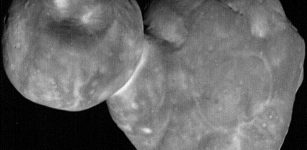Dragonfly: First Robot Will Sample Multiple Sites On Titan While Flying
Eddie Gonzales Jr. – MessageToEagle.com – NASA has announced that the Dragonfly mission will fly to multiple locations to sample and examine sites around Saturn’s icy moon, Titan, a unique, richly organic world.
Dragonfly will launch in 2026 and arrive in 2034.
 This illustration shows NASA’s Dragonfly rotorcraft-lander approaching a site on Saturn’s exotic moon, Titan. Credits: NASA/JHU-APL
This illustration shows NASA’s Dragonfly rotorcraft-lander approaching a site on Saturn’s exotic moon, Titan. Credits: NASA/JHU-APL
The robot (a multi-rotor flying vehicle ) will fly to several locations on Titan looking for prebiotic chemical processes common on both Titan and Earth. It has eight rotors and flies like a large drone. It will take advantage of Titan’s dense atmosphere – four times denser than Earth’s – to become the first vehicle ever to fly its entire science payload to new places for repeatable and targeted access to surface materials.
During its 2.7-year mission, Dragonfly will explore diverse environments and study how far prebiotic chemistry may have progressed and investigate Titan’s atmospheric and surface properties and its subsurface ocean and liquid reservoirs.
The robot will first land at the equatorial “Shangri-La” dune fields (similar to the linear dunes in Namibia in southern Africa); and then, it will take samples in multiple locations on the moon. Finally it will reach the Selk impact crater, where there is evidence of past liquid water. The lander will eventually fly more than 108 miles (175 kilometers) across Titan.
“Titan is unlike any other place in the solar system, and Dragonfly is like no other mission,” said Thomas Zurbuchen, NASA’s associate administrator for Science at the agency’s Headquarters in Washington, said in a press release.
“It’s remarkable to think of this rotorcraft flying miles and miles across the organic sand dunes of Saturn’s largest moon, exploring the processes that shape this extraordinary environment. Dragonfly will visit a world filled with a wide variety of organic compounds, which are the building blocks of life and could teach us about the origin of life itself.”
Titan has a nitrogen-based atmosphere like Earth. Unlike Earth, it has clouds and rain of methane. Other organics are formed in the atmosphere and fall like light snow. The moon’s weather and surface processes have combined complex organics, energy, and water similar to those that may have sparked life on our planet.
Titan is larger than the planet Mercury and is the second largest moon in our solar system. As it orbits Saturn, it is about 886 million miles (1.4 billion kilometers) away from the Sun, about 10 times farther than Earth. Because it is so far from the Sun, its surface temperature is around -290 degrees Fahrenheit (-179 degrees Celsius). Its surface pressure is also 50 percent higher than Earth’s.
Written by Eddie Gonzales Jr. – MessageToEagle.com Staff










